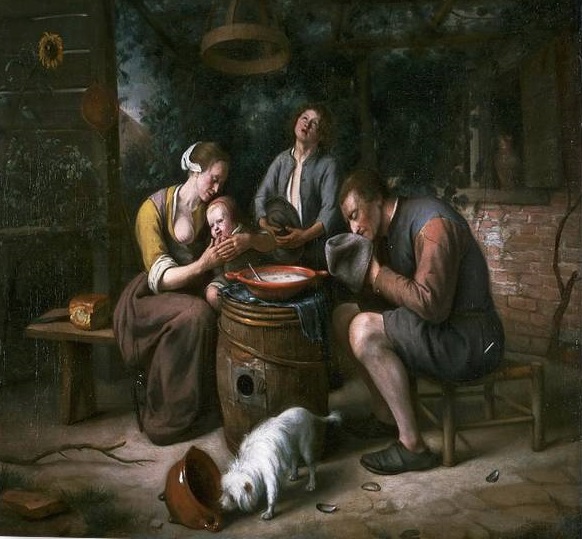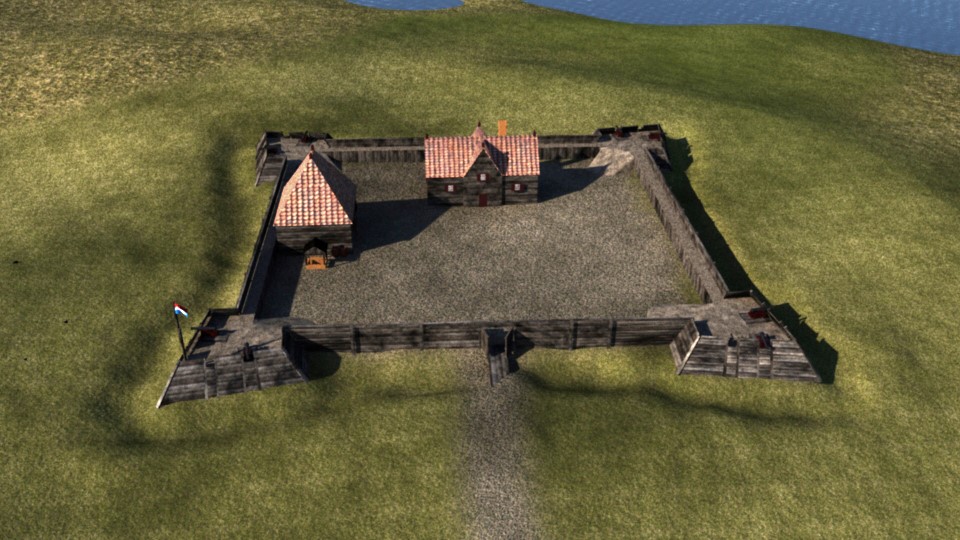Featured Fragment –A Kookpot from Casimir
By William Liebeknecht
Our story starts in 1651 with the construction of Fort Casimir, a colonial fortification built by the West India Company in what is now New Castle, Delaware. The four-sided fort was only lightly equipped with battle gear (Figure 1). In 1654, a Swedish force attacked the fort, leading the small, unprepared Dutch garrison at Fort Casimir to surrender. In September of the following year (1655), a Dutch West India Company task force of 300 men pressured the Swedish commander to surrender the fort back to the Dutch. In 1657, the City of Amsterdam took control of the community that had developed around Fort Casmir over the years and renamed it New Amstel (Bontemantel 2011:58). This new community was once again contested, as in 1664 an English force under Sir Robert Carr conquered New Amstel and the fort changed hands again. During the assault, the fort was severely damaged by a cannon barrage from two ships. By 1671, the fort was in ruins and it was leveled by 1678, with the land passing into private hands (Heite and Heite 1986:21).

Figure 1: Virtual Model of How the Fort May Have Looked Based on Archaeological and Historical Research (Image curtesy of Archae3d 2020).
The exact location of the fort had been in question since it faded from memory and the town of New Castle expanded over the past three centuries. Formal archaeological studies to locate the fort were completed in 1986 (Heite and Heite 1989) and again in 2012 (Leach et al. 2013). Seeking to find confirmation of the fort’s location and design, the New Castle Historical Society (NCHS) obtained a grant from the American Battlefield Protection Program to complete additional studies. A three-firm project team—South River Heritage Consulting, Dovetail Cultural Resources Group, and Archae 3D—led the 2020 efforts to further investigate the fort site. The team also included a host of volunteers, visiting archaeologists and retired archaeologists with an interest in the project, including New Holland Foundation archaeologist Hans van Westing (Catts et al. 2020).
The fort was four sided with bastions at the corners and a moat or ditch surrounding the exterior walls for added protection. Much to the delight of the team, the eastern dry moat/ditch was firmly located and defined during the archaeological survey. Approximately 10 percent of the moat was sampled revealing several nearly complete Dutch red-bodied earthenware ceramic vessels (kookpan, kookkan, and stoofpan). Small pieces of “vetro a fili” glass, majolica and faience earthenware plate, yellow brick, red roof tiles, tobacco pipes, food remains, and a lead shot were found in the moat. Overall more than 950 artifacts were recovered—most relating to the period of the fort’s occupation
One of the more interesting finds was a red-bodied earthenware vessel known as a kookpot recovered from the fill of the moat. The kookpot (formerly referred to by archaeologists as grape or grapen; see Janowitz and Schaefer 2020), kookkan, and stoofpan forms exhibit three feet, a single handle, and a spout (Schaeffer 1994:78–79). Hurst et al. (1986:130) describe these vessels as composed of a hard, red clay with fine quartz sand temper that range in color from brown to orange and red (Photo 1). The clear lead glaze that coats the outside ranges from yellow to greenish brown. While the name implies that these vessels were used in cooking, there is no evidence of burning or sooting on the bases of these objects, so they were likely cracked or broken in transport to the fort and never used in food preparation or exposed to a heat source. The size of the broken sherds of this vessel found in the moat and the fact that they mend indicate that they were discarded right away and not thrown in later when the fort was leveled. Once an insignificant utilitarian object, that was never likely even used, has shed an incredible amount of data on this pivotal Delaware site.

Photo 1: Prayer Before the Meal. Note the red-bodied earthenware kookpot on the ground that the dog is licking (Steen 1667-1671).

Photo 2: Mended Kookpot Recovered During Excavations at Fort Casimir.
Click here to view the 3d model of the fort created by Archae3d https://sketchfab.com/3d-models/model-of-fort-casimir-97ce934cdaa34f8db0321c9a063271e1
Any distributions of blog content, including text or images, should reference this blog in full citation. Data contained herein is the property of Dovetail Cultural Resource Group and its affiliates.
References:
Bontemantel, Hans
2011 New Netherland Papers, C. 1650 -1660, From the Collected Papers of Hans Bontemantel, Director of the Amsterdam Chamber of the West India Company, Held by the New York Public Library. Translated by Dingman Veersteeg, edited by Martha Dickinson Shattuck. New Netherland Research Center and the New Netherland Institute. Electronic document, https://www.newnetherlandinstitute.org/research/online-publications/the-new-netherlandpapers-of-hans-bontemantel/, accessed May 2020,
Catts, Wade P., William Liebeknecht, Kevin C. Bradley, Brian Crane, Kerry González, and P. Brad Hatch
2020 “…The soldiers never stopping until they stormed ye fort….” Report on the Archaeological Survey of the Battle for Fort Casimir (7NC-E-105E) City of New Castle, Delaware American Battlefield Protection Program Grant GA 2287-016-007 Prepared for New Castle Historical Society 30 Market Street New Castle, Delaware.
Heite, Edward, F. and Louise Heite
1986 Fort Elfsborg, 1643; A Background Study of the Fort Elsinboro Point or Fort Elfsborg, Elsinboro Township, Salem County, New Jersey and New Castle County, Delaware. Philadelphia District, Corps of Engineers. Manuscript on file at the Delaware State Historic Preservation Office.
1989 Report of Phase I Archaeological and Historical Investigations at the site of Fort Casimir, New Castle, Delaware. Prepared for the Trustees at New Castle Common. Manuscript on file at the Delaware State Historic Preservation Office.
Hurst, John G., David S. Neal, and H.J.E Van Beuningen
1986 Pottery Produced and Traded in North-West Europe 1350-1650. Rotterdam Papers VI. Stichting ‘Het Nederlandse Geruiksvoorwerp’, Rotterdam.
Janowitz, Meta and Richard G. Schaefer
2020 By Any Other Name: Kookpotten or Grapen? Little Pots, Big Stories. In The Archaeology of New Netherland: Uncovering a Forgotten World, edited by Craig Lukezic and John P. McCarthy. University Press of Florida, Gainesville.
Leach, Peter, Wade P. Catts, and Craig Lukezic
2013 “The starting Point in the Historic of New Castle”: Geophysics and the Exploratory Archaeology at the site of Fort Casimir (7NC-E-105E), City of New Castle, Delaware. John Milner associates. On file at the Delaware Division of Historical and Cultural Affairs, Dover.
Schaefer, Richard Gerhard
1994 A typology of seventeenth-century Dutch ceramics and its implications for American historical archaeology. Ph.D. dissertation, University of Pennsylvania.
Steen, Jan
1667-1671 Prayer Before the Meal. Philadelphia Museum of Art. www.philamuseum.org/collections/permanent/102302.html, accessed September 2020.

